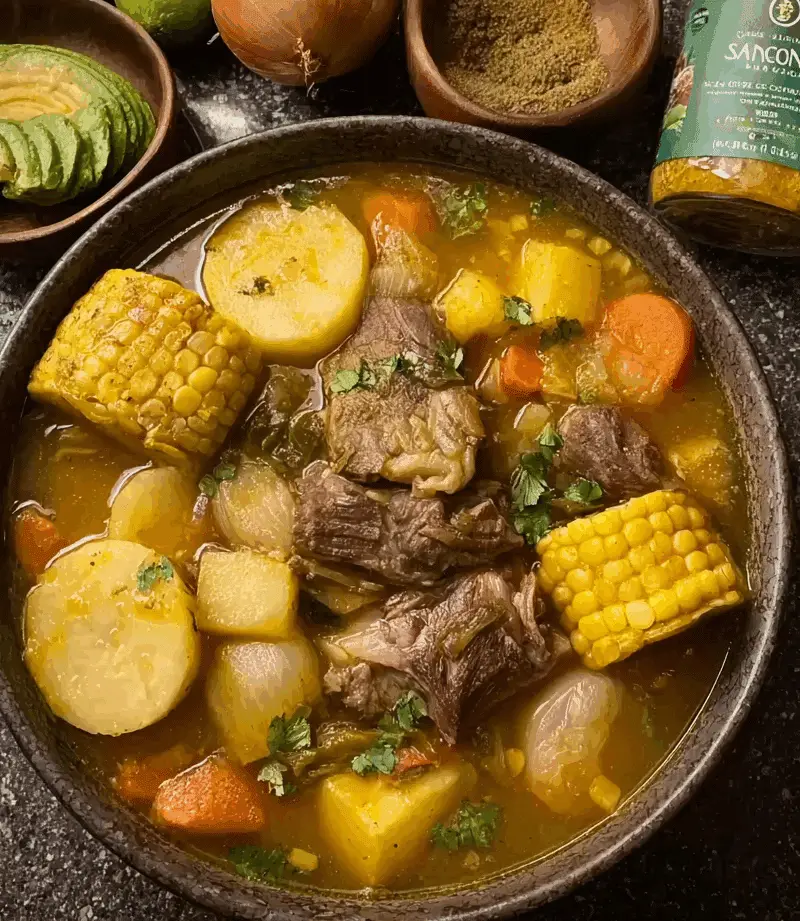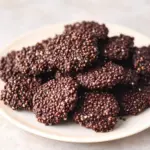This traditional Dominican sancocho is a soul-nourishing stew that brings together tender chicken and beef, hearty root vegetables, and sweet corn in a fragrant broth. It’s the kind of comforting dish perfect for family gatherings or chilly evenings when you crave warmth and flavor.
With every spoonful, you’ll taste the vibrant blend of oregano, cumin, fresh cilantro, and a squeeze of lime—ingredients that create a harmonious symphony of taste. Serve it in deep bowls with extra broth and a side of white rice for a truly indulgent experience.
Full Recipe
Ingredients:
-
1 lb chicken pieces (drumsticks or thighs)
-
1 lb beef short ribs, cut into chunks
-
2 ears of corn, cut into 2″ rounds
-
2 green plantains, peeled and cut into chunks
-
2 yellow yuca roots, peeled and cut
-
1 cup diced pumpkin (calabaza)
-
2 medium potatoes, peeled and cubed
-
1 medium onion, chopped
-
1 bell pepper, chopped
-
3 cloves garlic, minced
-
1 tbsp oregano
-
2 tsp cumin
-
1 tsp thyme
-
8 cups chicken or beef broth
-
Juice of 1 lime
-
2 tbsp chopped fresh cilantro
-
Salt and pepper to taste
-
2 tbsp olive oil
Directions:
-
Heat olive oil in a large pot over medium-high heat. Season chicken and beef with salt, pepper, oregano, cumin, and thyme.
-
Brown the meat pieces on all sides, about 8–10 minutes.
-
Add onion, bell pepper, and garlic; sauté until translucent, about 4 minutes.
-
Pour in broth and bring to a simmer. Skim foam off the top.
-
Add corn, plantains, yuca, pumpkin, and potatoes. Cover and simmer on low for 45–50 minutes until meat and vegetables are tender.
-
Stir in lime juice and cilantro. Adjust salt and pepper; simmer 2 more minutes.
-
Remove from heat; let rest for 5 minutes before serving.
Prep Time: 20 minutes | Cooking Time: 1 hour | Total Time: 1 hour 20 minutes | Kcal: ~450 kcal per serving | Servings: 6 servings
The Cultural Significance of Sancocho
Sancocho is far more than just a stew — it is a culinary icon in the Dominican Republic and across many Latin American countries. Rooted in indigenous, African, and Spanish traditions, this dish has evolved to become a symbol of community, heritage, and celebration. In the Dominican Republic, Sancocho often makes its grand appearance during holidays, family reunions, and special gatherings. Its preparation is seen as an act of love and unity, typically requiring multiple hands in the kitchen and hours of simmering to develop its rich, comforting flavors.
This stew is not merely food — it’s part of the cultural identity of a people who have passed the recipe down through generations. It is common for Dominicans to say, “No hay mejor comida que un buen sancocho,” which means “There is no better food than a good sancocho.” It reflects the warmth of Caribbean hospitality and the importance of food in bringing families and friends together.
What Makes Dominican Sancocho Unique?
While many Latin American countries have their own variations of sancocho, the Dominican version stands out due to its combination of meats and vegetables. Unlike other versions that might use only one or two proteins, Dominican sancocho traditionally includes a mix of beef, chicken, and sometimes pork. This mix is often referred to as “sancocho de siete carnes” or “seven-meat stew,” which is reserved for very special occasions.
The broth is deeply layered, aromatic with garlic, onions, oregano, and citrus — typically lime juice — which gives it a unique tanginess. Root vegetables like yuca, plantains, and potatoes are not just filler ingredients but essential components that contribute texture, earthiness, and substance to the dish. These ingredients also reflect the agricultural richness of the Dominican countryside and the traditional way of eating—hearty, resourceful, and nutrient-dense.
A Nutritional Powerhouse in One Bowl
Sancocho is as wholesome as it is hearty. Thanks to the root vegetables like yuca (cassava), plantains, and pumpkin, it’s packed with essential vitamins and minerals such as Vitamin A, potassium, and fiber. The meats provide high-quality protein and iron, while the fresh herbs like cilantro contribute antioxidants.
While it’s often seen as an indulgent comfort food, sancocho can be a balanced and nutritious meal when portioned correctly. The natural broth is hydrating and warming, and the slow cooking method helps retain most of the nutrients in the ingredients. For people seeking comforting meals that still offer nutritional value, sancocho is a top-tier choice.
Traditional Cooking Techniques That Build Flavor
The success of a Dominican sancocho lies in the technique, not just the ingredients. First, the meat is typically seasoned with a blend of lime juice, garlic, oregano, salt, and pepper before being browned to build a deep, savory foundation. This caramelization process is essential, as it adds a richness that permeates the entire stew.
The broth is simmered slowly to ensure every layer of flavor has time to bloom. The vegetables are added in stages, depending on their cook times, to prevent them from becoming mushy. This careful orchestration of timing ensures that each bite has the perfect balance of tender meats and perfectly cooked root vegetables.
Another traditional practice is to let the finished stew sit for a few minutes before serving. This resting period allows the flavors to meld further, enhancing the overall experience.
Regional and Household Variations
Though the base components of sancocho remain consistent, it’s common to see different versions depending on the region or even household preferences. In coastal areas, you might find fish or seafood used in place of beef or chicken. In the countryside, locally available vegetables like malanga or taro root might replace potatoes.
Some families might skip certain meats due to budget constraints or dietary choices, which is a reminder of the dish’s adaptability. Others might include rice served on the side or directly in the bowl. A dollop of avocado or a spoonful of hot sauce can be added just before eating, tailoring the experience to the eater’s liking.
These variations are part of what makes sancocho a living recipe — one that adapts and evolves while still honoring its roots.
Perfect Pairings and Serving Tips
Sancocho is typically served with white rice, which acts as a neutral companion to the rich broth and bold flavors. A few lime wedges on the side help cut through the heaviness, adding brightness and balance. Some families enjoy it with sliced avocado, which adds creaminess to each spoonful. Others pair it with crispy tostones (fried green plantains) for contrast.
A chilled beverage like “morir soñando” (a Dominican drink made with orange juice and milk) or tamarind juice complements the heartiness of the stew. And of course, no sancocho gathering is complete without good company, laughter, and stories shared around the table.
Why Sancocho Feels Like a Hug in a Bowl
There’s something undeniably emotional about Dominican sancocho. Maybe it’s the way it warms your hands when you cradle the bowl. Maybe it’s the aroma that reminds you of your grandmother’s kitchen or the feeling of coming home. The slow cooking, the sharing, the tradition — all of it speaks to the care and connection that food can bring.
Sancocho is a dish meant to be shared. Whether it’s a family Sunday lunch, a festive gathering, or a cozy dinner for two, it brings people together and encourages slowing down to savor life’s simpler moments.
Conclusion
Dominican sancocho is more than just a stew — it is a cultural expression, a culinary tradition, and a symbol of warmth and unity. With its blend of meats, root vegetables, and herbs, it captures the heart of Dominican cooking in every spoonful. It’s a recipe that invites improvisation while still staying true to its roots, allowing each cook to put their own mark on it.
Whether you’re exploring Caribbean cuisine for the first time or reconnecting with family roots, making sancocho is a rewarding experience. It teaches patience, showcases the richness of simple ingredients, and proves that some of the most memorable meals are those that take time, love, and a little bit of tradition.
So the next time you’re craving comfort food that feeds both body and soul, sancocho should be at the top of your list.








